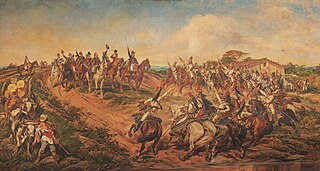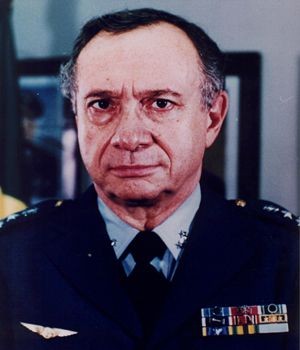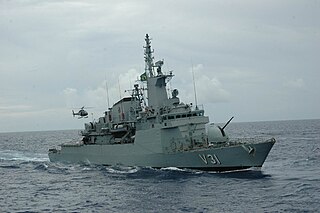The Brazilian Navy is the naval service branch of the Brazilian Armed Forces, responsible for conducting naval operations.

USS Hermitage (LSD-34) was a Thomaston-class dock landing ship of the United States Navy. She was named for The Hermitage, President Andrew Jackson's estate just outside Nashville, Tennessee.

The Museu Paulista of the University of São Paulo, commonly known as Museu do Ipiranga, is a Brazilian history museum located near the place where Emperor Pedro I proclaimed Brazil's independence on the banks of Ipiranga brook in the Southeast region of the city of São Paulo, then the "Caminho do Mar," or road to the seashore. It contains a huge collection of furniture, documents and historically relevant artwork, especially relating to the Brazilian Empire era.

The Inhaúma class are a series of five corvettes operated by the Brazilian Navy. These ships were built in Brazil and designed with assistance from the German company Marine Technik. It was originally planned to build 12 to 16 ships but the economic situation in Brazil did not permit this and only five vessels were built. The first two ships were constructed at the Arsenal de Marinha in Rio de Janeiro, the second pair by Verolme. The programme was considerably delayed due to funding issues and the Brazilian Verolme yard's insolvency in 1991 which forced Júlio de Noronha and Frontin to be completed by Arsenal da Marinha. The first ship entered service in 1989 and the last in 2008. Three of the five ships have been taken out of service and one was sunk in a missile exercise in the Atlantic Ocean in 2016.

The independence of Brazil comprised a series of political and military events that led to the independence of the Kingdom of Brazil from the United Kingdom of Portugal, Brazil and the Algarves as the Brazilian Empire. It is celebrated on 7 September, the date when prince regent Pedro of Braganza declared the country's independence from the United Kingdom of Portugal, Brazil and the Algarves on the banks of the Ipiranga brook in 1822 on what became known as the Cry of Ipiranga. Formal recognition by Portugal came with the Treaty of Rio de Janeiro, signed in 1825.

Alexandre Rodrigues Ferreira was a Portuguese naturalist born in Brazil. He undertook an extensive journey which crossed the interior of the Amazon Basin to Mato Grosso, between 1783 and 1792. During this journey, he described the agriculture, flora, fauna, and native inhabitants.

Barroso (V34) is a corvette of the Brazilian Navy, and the lead ship of its sub class. The fifth Brazilian warship to be named after Admiral Francisco Manoel Barroso da Silva, Barroso was launched on 20 December 2002 and commissioned on 19 August 2008.

Tércio Pacitti, São Paulo, Brazil was an electronic engineer and computer scientist in Brazil.

The Monument to the Independence of Brazil is a granite and bronze monument located in the Independence Park in São Paulo, Brazil. It is also known as the Ipiranga Monument or the Altar of the Fatherland. The monument is located on the banks of the Ipiranga Brook, on the historic site where prince regent Pedro proclaimed the independence of the country on 7 September 1822.

Museu da Imagem e Som de Alagoas is a Brazilian museum located in Maceió, on the state of Alagoas. It was opened on September 3, 1981, with the purpose of preserving the state's audiovisual heritage. Its curatorship is done by the State Secretariat for Culture.

Ilques Barbosa Junior is a Brazilian Admiral of the Fleet, former Chief of General Staff and Commander of the Navy from January 2019 to March 2021.

Liberal (F43) is a Niterói-class frigate of the Brazilian Navy. She was the fourth ship of her class ordered by the Brazilian Navy, on 20 September 1970. Liberal was launched on 7 February 1977, and was commissioned on 18 November 1978.

Jaceguai(V31) was the second ship of the Inhaúma-class corvette of the Brazilian Navy.

Frontin(V33) was the fourth ship of the Inhaúma-class corvette of the Brazilian Navy.

The Brazilian ironclad Colombo was a Cabral-class armored corvette-type ironclad operated by the Imperial Brazilian Navy between 1866 and 1875. The vessel was built in the shipyard in Greenwich, England, by the British company J. and G. Rennie, along with her sister ship Cabral. It was launched in 1865 being commissioned on 4 July 1866. The battleship was entirely made of iron, displacing 1,069 tons. It had two steam engines that developed up to 750 HP of power, propelling the vessel at about 20 km/h. Its structure comprised a double casemate with eight gunports. The Brazilian navy had great difficulties with this ship, which was hard to navigate and, due to the casemate's model, had an unprotected section, which was vulnerable to diving projectiles.

Pedro II was a steam corvette warship that served in the Imperial Brazilian Navy in the second half of the 19th century. It took part in the Platine War.

Feliz Lusitânia, now known as Conjunto Arquitetônico e Paisagístico Feliz Lusitânia or Complexo Turístico Feliz Lusitânia, was a Portuguese colonial settlement created in 1616 by Captain Francisco Caldeira Castelo Branco in the then Conquista do Pará, at the time of the overseas province of Colonial Brazil, originating the Pará municipality of Belém. Feliz Lusitânia is the historical center of this municipality, located in the district of Cidade Velha, a port and tourist area restored in 2002 by the Government of the State of Pará, when the city was going through a process of historical urban decay due to verticalization.
Culture and tourism in Belém, the capital of Pará, is influenced by indigenous people and foreign immigrants, who manifest themselves through religious manifestations, gastronomy, folklore, dances, music, theaters, museums, among others. Belém stands out as a great tourist destination in Brazil, creating an excellent opportunity for travel investment.

Ipiranga (V17) was a corvette of the Imperial Marinheiro class constructed for the Brazilian Navy. The ship was laid down in 1953 and launched in 1954. The vessel entered service in 1955 and was primarily used for enforcement of Brazil's territorial waters and district patrols. Based on a sea-going tugboat design, the corvette was also capable of performing coast guard duties such as towing and was equipped for firefighting. Ipiranga could also be converted for minesweeping and minelaying duties. In 1961, Ipiranga was deployed to prohibit French encroachment on Brazilian fisheries. In 1983, the corvette struck an underwater pinnacle and sank off the northeast coast of Brazil.
















